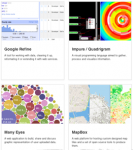Community Embraces New Word Game at Mid-Year Play Day This past Sunday, families at Takoma Park’s Seventh Annual Mid-Year Play Day had the opportunity to experience OtherWordly for the first time. Our educational language game drew curious children and parents to our table throughout the afternoon. Words in Space Several children gathered around our iPads […]
Read moreCategory: Technology
A new generation of small video cameras and consumer robotic helicopters make amazing video shots possible. Stick your phone on a drone for enchanting views of the natural world, architecture, museums, and more. Here’s a cool new video flying a drone around the NY public library:
 Most data is meaningless to most people — unless it is visualized. Stepping beyond familiar visualizations like bar charts and pie charts, there are many approaches to visualizing data, from mapping (e.g., color coding a map to show voting patterns) to visualizing networks (e.g., the links between people).
Most data is meaningless to most people — unless it is visualized. Stepping beyond familiar visualizations like bar charts and pie charts, there are many approaches to visualizing data, from mapping (e.g., color coding a map to show voting patterns) to visualizing networks (e.g., the links between people).
You are not limited to Microsoft Excel, or your own programming abilities. We’re now in an awesome generation for visualization, with dozens of freely available software libraries — which developers have spent months (or years!) building. Increasingly these use Javascript (so they work in all browsers and mobile devices). The folks at Datavisualization.ch highlight most of the best tools for making maps and charts, or processing data… (more…)
![]() Science journal subscriptions can cost libraries several thousand dollars a year, yet most institutions members only make use of a few articles from each of these journals. The huge subscription expenses limit how many journals each school or company can carry. Even single article pricing can be staggering, at $30-50 each. Sinisa Hrvatin, a doctoral candidate at Harvard, and his roommate Robert McGrath believe they have a better way. (more…)
Science journal subscriptions can cost libraries several thousand dollars a year, yet most institutions members only make use of a few articles from each of these journals. The huge subscription expenses limit how many journals each school or company can carry. Even single article pricing can be staggering, at $30-50 each. Sinisa Hrvatin, a doctoral candidate at Harvard, and his roommate Robert McGrath believe they have a better way. (more…)
 When deciding what software to use for a project, how do you decide on open source vs. proprietary software? For example, in prior post on social networking software, there are some free options (assuming you have a developers on hand), and some expensive options. Here’s a summary of the typical pros and cons for Open Source. (more…)
When deciding what software to use for a project, how do you decide on open source vs. proprietary software? For example, in prior post on social networking software, there are some free options (assuming you have a developers on hand), and some expensive options. Here’s a summary of the typical pros and cons for Open Source. (more…)

IDEA’s second mobile app, WikiNodes (see app store link) puts the encyclopedic knowledge of Wikipedia at the fingertips of iPad users. Articles are displayed as nodes that can be touched, dragged and spun around — showing the relations between articles and sections of articles. The app is currently featured in Apple’s app store.
Here’s a 30 second demo:
The app is based on IDEA’s SpicyNodes system for displaying and navigating information using nodes (see SpicyNodes.org). The SpicyNodes approach has great potential for other subjects, from browsing museum collections and archives, to browsing flora & fauna, and many other kinds of linked data.
 Games on mobile devices are a new way to engage museum visitors. Two companies gave presentations at yesterday’s Museums & Mobile 2011 online conference.
Games on mobile devices are a new way to engage museum visitors. Two companies gave presentations at yesterday’s Museums & Mobile 2011 online conference.
One popular type of game is a miniature scavenger hunt, called “location-gaming.” The premise is that players go places (e.g., a restaurant or park), do fast, simple tasks (like typing something into their phone, or uploading a photo of something), and win a reward (the reward can virtual “points,” or something tangible, like a free postcard or sandwich). Other types of games are more thematic, such as creating playing-card “battles” between characters that appear in art. (more…)
 Museums are going mobile, and many companies are eager to help. At yesterday’s Museums & Mobile 2011 online conference, several vendors promoted their wares. This is a summary of products, approaches, and some alternatives… (more…)
Museums are going mobile, and many companies are eager to help. At yesterday’s Museums & Mobile 2011 online conference, several vendors promoted their wares. This is a summary of products, approaches, and some alternatives… (more…)
 If you put information online, getting traffic is always a challenge. Web traffic may come from “organic” search results, from blogs, from Twitter & Facebook, from bookmark sites, etc. (And if you are a nonprofit, via free AdWords via a Google Grant.) There are many resources online about “search engine optimization.” But don’t confuse the approach for education with that needed for commerce. According to a search engine hacker Mark Stevens, interviewed recently by the New York Times:
If you put information online, getting traffic is always a challenge. Web traffic may come from “organic” search results, from blogs, from Twitter & Facebook, from bookmark sites, etc. (And if you are a nonprofit, via free AdWords via a Google Grant.) There are many resources online about “search engine optimization.” But don’t confuse the approach for education with that needed for commerce. According to a search engine hacker Mark Stevens, interviewed recently by the New York Times:
“I think we need to make a distinction between two different kinds of searches — informational and commercial,” he said. “If you search ‘cancer,’ that’s an informational search and on those, Google is amazing. But in commercial searches, Google’s results are really polluted. My own personal experience says that the guy with the biggest S.E.O. budget always ranks the highest.”


 Cloud computing is a metaphorical term for hosted services on the Internet. This can be infrastructure (i.e., raw equipment), platforms (e.g., operating systems, basic software like databases or web servers), or software (e.g., content managements systems, social networking software). Typically, it is sold on metered basis, like a utility charges for water.
Cloud computing is a metaphorical term for hosted services on the Internet. This can be infrastructure (i.e., raw equipment), platforms (e.g., operating systems, basic software like databases or web servers), or software (e.g., content managements systems, social networking software). Typically, it is sold on metered basis, like a utility charges for water. Today,
Today,